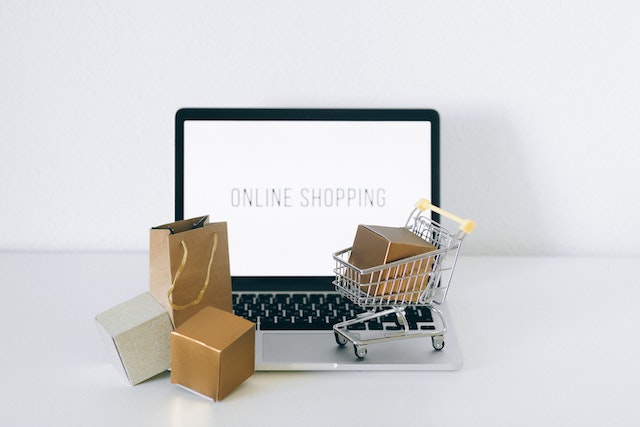The fashion industry has always been a buzzing hive of creativity and entrepreneurship. Now, with the digital revolution, launching your own clothing line from the comfort of your home has become more accessible than ever.
Photo by Nataliya Vaitkevich: https://www.pexels.com/photo/brown-cardboard-box-on-stainless-steel-shopping-cart-6214474/
If fashion is your passion and you’ve envisioned building your own brand, the online world is your oyster. Here’s a step-by-step guide to turning that vision into a profitable reality.
Establishing Your Brand Identity
Your brand identity is the backbone of your online clothing store. It’s more than just colors and logos—it’s the emotional and psychological relationship your customers have with your business.
In a saturated market, your brand identity can make you stand out and build a loyal customer base. It’s the promise you make to your audience and the emotions you want them to feel when they interact with your business.
Define Your Niche
Starting any kind of clothes business requires defining your niche. Understanding and defining your niche is the first step to cater to specific consumer needs that larger corporations might overlook.
Demographics and Interests: Every age group, gender, or profession has distinct clothing preferences. By identifying your primary audience—be it college students, working professionals, or fitness buffs—you can tailor your designs and marketing campaigns more effectively. Consider:
- Age Range: Are you targeting millennials or baby boomers?
- Geographic Location: Urban trendy or countryside classic?
- Lifestyle Choices: Eco-friendly, luxury, or budget-friendly?
Unique Selling Proposition (USP): In today’s competitive market, having a strong USP is crucial. It’s the reason customers will choose you over competitors.
- Sustainable Fashion: With growing environmental consciousness, eco-friendly materials or ethical manufacturing could be your edge.
- Exclusive Designs: Limited edition pieces can create a sense of exclusivity.
- Cultural Fusion: Blending elements from different cultures can cater to a global audience or diaspora communities.
Create A Memorable Brand Name and Logo
Your brand name and logo are often the first things potential customers will notice.
Name: This isn’t just a label—it’s a reflection of your brand’s personality and values.
- Relevance: Ensure your name resonates with the kind of clothes you’re selling.
- Originality: A unique name can stand out in a sea of competitors.
- Future Growth: Ensure the name can accommodate future expansion into new lines or products.
Logo: This visual cue should be instantly recognizable and evoke the essence of your brand.
- Simplicity: Often, the most memorable logos are simple and uncluttered.
- Versatility: It should be adaptable across various mediums, from website headers to product tags.
- Consistency: Keep your logo consistent in terms of colors and design across all platforms.
Develop Your Brand Story
Narratives are powerful. A compelling brand story can connect emotionally with customers and build brand loyalty.
Origins: Sharing your brand’s origin story helps humanize your business.
- Personal Touch: Did a personal experience inspire you to start the business?
- Challenges Overcome: Sharing struggles and triumphs can be inspiring.
Mission Statement: This is the guiding star of your business. It dictates every decision and action of your brand.
- Values: What principles drive your brand? Sustainability? Craftsmanship?
- Vision: Where do you see your brand in 5, 10, or 20 years?
- Community Impact: How is your brand making a difference in the community or the world at large?
Choosing the Best eCommerce Platform
The eCommerce platform you select will be the digital storefront of your online clothing store.
The right choice will provide a seamless shopping experience for your customers and straightforward management for you.
In a time where online shopping is more prevalent than ever, the platform you use can significantly impact your store’s success.
Analyze Your Needs
Before zeroing in on an eCommerce platform, it’s essential to define what you need from it.
Inventory Size: Depending on the scale of your operations, the required features can vary.
- Large Inventories: Platforms like Shopify or Magento are robust and can handle extensive product lines with ease.
- Small Collections: For boutique stores or designers just starting out, platforms like Wix or Etsy might be more appropriate.
Customization:
- Branding: If you have a specific vision for your store’s design, you’ll need a platform that offers flexibility in themes and design customization. WordPress with WooCommerce, for instance, is known for its high customizability.
- Features: Some platforms come with built-in tools like CRM or email marketing. Decide which tools are essential for your operations.
Consider Budget and Fees
Financial considerations play a pivotal role in your choice of platform.
Setup Costs:
- Free Platforms: Solutions like WooCommerce for WordPress might not have setup fees, but there could be costs associated with web hosting or premium plugins.
- Premium Platforms: Platforms like Shopify or BigCommerce have monthly charges, but they include hosting and continuous updates.
Transaction Fees:
- Commission-Based: Platforms like Etsy or eBay will take a percentage of each sale.
- Flat Rate: Some platforms might charge a consistent monthly fee regardless of sales volume. It’s crucial to understand these structures to price your products effectively.
Prioritize User Experience
The customer’s shopping experience is crucial for repeat business and word-of-mouth marketing.
Mobile Responsiveness:
- Adaptive Design: Given the rising trend of mobile shopping, ensure your chosen platform’s themes are mobile-responsive. Sites should load quickly and display correctly on various screen sizes.
- Mobile Features: Features like one-click shopping, Apple Pay or Google Wallet integrations can make mobile shopping a breeze.
Payment and Checkout Process:
- Multiple Payment Options: Providing various payment methods, from credit cards to digital wallets, can cater to a wider audience.
- Checkout Experience: Simplify the checkout process. Fewer steps can mean fewer opportunities for a customer to abandon their cart. Integrating features like guest checkouts or saving payment information for returning customers can also enhance the user experience.
Crafting and Managing Your Inventory
A store’s inventory is its backbone. For an online clothing store, the inventory needs to not only reflect the brand’s ethos but also resonate with the target audience.
Effectively crafting and managing this inventory is crucial for business success, profitability, and sustainability.
Quality Over Quantity
While it might be tempting to offer a wide variety of products, the quality of each item is paramount.
Material Selection:
- Sourcing: Finding sustainable or premium materials can boost your brand’s value proposition. For instance, if sustainability is a cornerstone of your brand, opt for organic cotton or recycled fabrics.
- Supplier Relationships: Building strong relations with suppliers ensures consistency in quality and can even lead to cost benefits in bulk purchases.
Quality Control:
- Inspection: Implementing a rigorous inspection process can help in catching defects early, reducing returns, and boosting customer satisfaction.
- Feedback Loop: Encourage feedback from customers. This can help in identifying recurrent issues and improving the product quality over time.
Set Appropriate Price Points
Setting the right price is a balance between profitability and market competitiveness.
Cost Analysis:
- Breakdown: Understand each cost component, from raw materials, labor, shipping, to even marketing. This detailed understanding ensures you’re not underpricing and hurting your margins.
- Margins: Decide on a profit margin that ensures sustainability while offering value to customers.
Market Research:
- Competitive Analysis: Look at similar products in your niche. Understanding the average price point can give you a starting ground.
- Perceived Value: Sometimes, the value of a product isn’t just in its cost but its brand, story, or unique selling proposition. Determine if these factors allow for a premium pricing strategy.
Inventory Management
Efficient inventory management is the key to smooth operations and reduced costs.
Stock Levels:
- Monitoring: Use inventory management software or tools to get real-time insights into stock levels. This helps in making informed purchasing decisions.
- Thresholds: Set minimum stock levels for each product. When stock dips below this level, it can trigger a reorder, ensuring you’re never out of stock on popular items.
Seasonal Updates:
- Trend Analysis: Keep an eye on fashion trends, ensuring your store stays current and relevant.
- Inventory Turnover: Aim for a healthy inventory turnover rate. Seasonal refreshes, clearance sales, or promotional events can help move older stock and make way for new collections.
Final Remarks
Launching your own online clothing store is no small feat, but with passion, precision, and a clear roadmap, it’s a journey that can lead to immense satisfaction and success.
Keep the customer at the heart of every decision, from crafting your brand story to selecting the best eCommerce platform.
As you navigate the intricate world of online retail, let your passion guide you, but always back it up with thorough research and planning. The world of fashion awaits your unique touch!





















